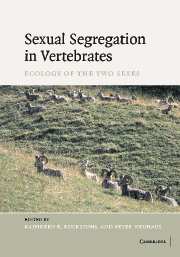Book contents
- Frontmatter
- Contents
- List of contributors
- Preface
- Part I Overview
- Part II Concepts and methodology
- Part III Foraging ecology
- Part IV Predator avoidance and reproductive strategies
- Part V Sex-related activities and social factors
- Part VI Sexual differences in ecology: comparisons within different taxa
- Part VII Implications for conservation
- 18 Sexual segregation in birds: patterns, processes and implications for conservation
- 19 Sexual segregation: a necessary consideration in wildlife conservation
- Part VIII Outlook
- References
- Index
19 - Sexual segregation: a necessary consideration in wildlife conservation
Published online by Cambridge University Press: 04 September 2009
- Frontmatter
- Contents
- List of contributors
- Preface
- Part I Overview
- Part II Concepts and methodology
- Part III Foraging ecology
- Part IV Predator avoidance and reproductive strategies
- Part V Sex-related activities and social factors
- Part VI Sexual differences in ecology: comparisons within different taxa
- Part VII Implications for conservation
- 18 Sexual segregation in birds: patterns, processes and implications for conservation
- 19 Sexual segregation: a necessary consideration in wildlife conservation
- Part VIII Outlook
- References
- Index
Summary
OVERVIEW
The importance of animal behaviour to the development of conservation strategies has received increased recognition in recent years. Behaviourists realize now that evolutionary studies rely on a diversity of species occurring in their natural habitats, whereas conservationists now recognize that animal behaviour plays a large role in ecological processes and, therefore, can have great implications for conservation. Several recent texts (Clemmons & Buchholz, 1997; Caro, 1998; Gosling & Sutherland, 2000; Festa-Bianchet & Apollonio, 2003) have been dedicated to this important union. Nonetheless, much remains to be learned about the specific ways by which animal behaviour influences populations, and how that knowledge can best be incorporated into effective conservation strategies (Shumway, 1999).
Sexual segregation is a behavioural and ecological phenomenon that can have great implications for wildlife conservation. A number of hypotheses have been proposed for explaining sexual segregation (Main et al., 1996; Ruckstuhl & Neuhaus, 2002; see general overview in Chapter 2). Understanding the causes of sexual segregation will provide further insight on the selective forces shaping animal behaviour and will lead to improved conservation strategies. Regardless of the mechanism(s) leading to sexual segregation, the outcome itself is an important issue that should be considered in conservation programmes. Indeed, the temporal and spatial groupings of males and females have implications for habitat management, population monitoring, research and management.
In this chapter, we review ways in which sexual segregation can influence effectiveness of conservation strategies.
- Type
- Chapter
- Information
- Sexual Segregation in Vertebrates , pp. 379 - 392Publisher: Cambridge University PressPrint publication year: 2006
- 3
- Cited by



